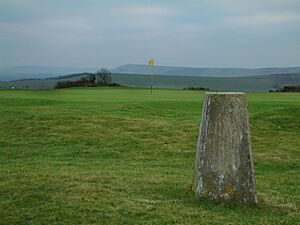Cliffe Hill facts for kids
Quick facts for kids Cliffe Hill |
|
|---|---|

The summit of Cliffe Hill
|
|
| Highest point | |
| Elevation | 164 m (538 ft) |
| Prominence | 152 m (499 ft) |
| Parent peak | Crowborough |
| Listing | Marilyn |
| Geography | |
| Location | South Downs, England |
| OS grid | TQ434107 |
| Topo map | OS Landranger 198 |
Cliffe Hill is a notable hill found just east of the town of Lewes in East Sussex, England. It stands out with its impressive western side, which looks over Lewes. The very top of the hill is home to a golf course. It is also one of the lowest Marilyn hills in England.
Contents
Exploring Cliffe Hill's History
Cliffe Hill is not just a place for great views; it also holds interesting stories from the past.
The Martyrs' Memorial
On the hill, you will find an obelisk called the Martyrs' Memorial. This monument remembers a sad time in history. It marks the destruction of Lewes's monastery by King Henry VIII and the burning of 17 Protestant martyrs. These events happened between 1555 and 1557. The obelisk is also near where a large bonfire was lit in 1606. This bonfire celebrated the first anniversary of the discovery of the Gunpowder Plot.
Ancient History on the Hill
Bronze Age Discoveries
Long ago, during the Bronze Age, a special burial mound called a barrow was on Cliffe Hill. This barrow was explored in 1930 before it was removed due to quarrying. Inside the barrow, archaeologists found several cremations. These were covered by a pile of flint stones called a cairn. The barrow was about 15 meters wide.
Golf Course and Ancient Sites
Interestingly, another type of ancient burial mound, a long barrow, is now part of the golf course. It is used as a hazard on one of the golf holes. This shows how old history and modern activities can exist side by side.
Visiting Cliffe Hill
Even though the top of Cliffe Hill is part of the Lewes golf course, you can still explore it. A public footpath runs along the southern side of the hill. From this path, you can easily reach the golf course. There are several special gates, called stiles, located along the southern edge of the course that allow access.


